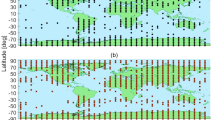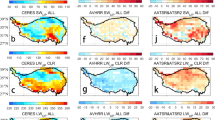Abstract
In the paper, we propose a new method of identifying the clear sky based on the Atmospheric Emitted Radiance Interferometer (AERI). Using the Atmospheric Radiation Measurement (ARM) Mobile Facility (AFM) dataset in Shouxian in 2008, we simulate the downwelling radiances on the surface in the 8–12 μm window region using Line-By-Line Radiative Transfer Model (LBLRTM), and compare the results with the AERI radiances. The differences larger (smaller) than 3 mW (cm2 sr cm−1)−1 suggest a cloudy (clear) sky. Meanwhile, we develop the new algorithms for retrieving the zenith equivalent cloud base height (CBHe) and the equivalent emissivity (ɛ e ), respectively. The retrieval methods are described as follows. (1) An infinitely thin and isothermal blackbody cloud is simulated by the LBLRTM. The cloud base height (H) is adjusted iteratively to satisfy the situation that the contribution of the blackbody to the downwelling radiance is equal to that of realistic cloud. The final H is considered as CBHe. The retrieval results indicate that the differences between the CBHe and observational cloud base height (CBH) are much smaller for thick low cloud, and increase with the increasing CBH. (2) An infinitely thin and isothermal gray body cloud is simulated by the LBLRTM, with the CBH specified as the observed value. The cloud base emissivity (ɛ c ) is adjusted iteratively until the contribution of the gray body to the downwelling radiance is the same as that of realistic cloud. The corresponding ɛ c is ɛ e . The average ɛ e for the low, middle, and high cloud is 0.967, 0.781, and 0.616 for the 50 cases, respectively. It decreases with the increasing CBH. The retrieval results will be useful for studying the role of cloud in the radiation budget in the window region and cloud parameterizations in the climate model.
Similar content being viewed by others
References
IPCC. Climate Change 2001. Cambridge: Cambridge University Press, 2001
Lü D R, Wang P C, Qiu J H, et al. An overview on the research progress of atmospheric remote sensing and satellite meteorology in China (in Chinese). Chin J Atmos Sci, 2003, 27: 552–566
Wang H Q, Zhao G X. Cloud and Radiation—I: Cloud climatology and radiative effects of clouds (in Chinese). Chin J Atmos Sci, 1994, 18(Suppl): 910–932
Arking A. The radiative effects of clouds and their impact on climate. Bull Amer Meteor Sci, 1991, 72: 795–813
Barker H W, Stephens G L, Fu Q. The sensitivity of domain averaged solar fluxes to assumptions about cloud geometry. Quart J Roy Meteor Soc, 1999, 125: 2127–2152
Schiffer R A, Rossow W B. The international Satellite Cloud Climatology Project (ISCCP): The first project of the World Climate Research Program. Bull Amer Meteor Soc, 1983, 64: 779–784
Cairns B. Diurnal variations of cloud from ISCCP data. Atmos Res, 1995, 37: 133–146
Hahn C J, Rossow W B, Warren S G. ISCCP cloud properties associated with standard cloud types identified in individual surface observations. J Clim, 2001, 14: 11–28
Jin Y, Rossow W B, Wylie D P. Comparison of the climatologies of high-level clouds from HIRS and ISCCP. J Clim, 1996, 9: 2850–2879
Rossow W B, Garder L C. Cloud detection using satellite measurements of infrared and visible radiances for ISCCP. J Clim, 1993, 6: 2341–2369
Rossow W B, Garder L C. Validation of ISCCP cloud detections. J Clim, 1993, 6: 2370–2393
Vaughan M, Young S, Winker D, et al. Fully automated analysis of space-based lidar data: An overview of the CALIPSO retrieval algorithms and data products. In: Singh U N, ed. Laser Radar Techniques for Atmospheric Sensing. Bellingham: SPIE-INT Soc Optical Engineering, 2004. 16–30
Sassen K, Wang Z. Classifying clouds around the globe with the CloudSat radar: 1-year of results. Geophys Res Lett, 2008, 35, doi: 10.1029/2007GI032591
Sassen K, Wang Z, Liu D. Global distribution of cirrus clouds from CloudSat/Cloud-Aerosol Lidar and Infrared Pathfinder Satellite Observations (CALIPSO) measurements. J Geophys Res, 2008, 113, doi: 10.1029/2008JI009972
Qiu J H, Lü D R. On lidar application for remote sensing of the atmosphere, Adv Atmos Sci, 1991, 8: 369–378
Campbell J R, Hlavka D L, Spinhirne J D, et al. Operational cloud boundary detection and analysis from micropulse lidar data. Proc Eighth ARM Science Team Meeting. Tucson: US Department of Energy, 1998. 119–122
Clothiaux E E, Miller M A, Albrecht B A, et al. An evaluation of a 94-GHz radar for remote sensing of cloud properties. J Atmos Ocean Technol, 1995, 12: 201–229
Clothiaux E E, Ackerman T P, Mace G G, et al. Objective determination of cloud heights and radar reflectivities using a combination of active remote sensors at the ARM CART sites. J Appl Meteor, 2000, 39: 645–665
Minnis P, Heck P W, Young D F, et al. Stratocumulus cloud properties derived from simultaneous satellite and island-based instrumentation during FIRE. J Appl Meteor, 1992, 31: 317–339
Chahine M. Remote sounding of cloudy atmospheres. 1. Single cloud layer. J Atmos Sci, 1974, 31: 233–243
Smith W L, Platt C M R. Comparison of satellite-deduced cloud heights with indications from radiosonde and ground-based laser measurements. J Appl Meteor, 1978, 17: 1796–1802
Smith W L, Frey R. On cloud altitude determinations from high-resolution interferometer sounder (HIS) observations. J Appl Meteor, 1990, 29: 658–662
Holz R E, Ackerman S, Antonelli P, et al. An improvement to the high-spectral-resolution CO2-slicing cloud-top altitude retrieval. J Atmos Ocean Technol, 2006, 23: 653–670
Mahesh A, Walden V P, Warren S G. Ground-based infrared remote sensing of cloud properties over the Antarctic Plateau, Part I: Cloud-base height. J Appl Meteor, 2001, 40: 1265–1278
Zhang W X, Lu D R, Chang Y L. A feasibility study of cloud base height remote sensing by simulating ground-based thermal infrared brightness temperature measurements (in Chinese). Chin J Ceophys, 2007, 50: 354–363
Feltz W F, Smith W L, Kauteson R O, et al. Meteorological applications of temperature and water vapor retrievals from the ground-based Atmospheric Emitted Radiance Interferometer (AERI). J Appl Meteor, 1998, 37: 857–875
Smith W L, Feltz W E, Knuteson R O, et al. The retrieval of planetary boundary layer structure using ground-based infrared spectral radiance measurements. J Atmos Oceanic Technol, 1999, 16: 323–333
Turner D D, Ackerman S A, Baum B A, et al. Cloud phase determination using ground-based AERI observations at SHEBA. J Appl Meteor, 2003, 42: 701–715
He H, McMillan W, Knuteson R O, et al. Retrieval of tropospheric CO column density from AERI spectra: Case study during March 2–4, 1998. Atmos Environ, 2001, 35: 509–514
Sheng P X, Mao J T, Li J G, et al. Atmospheric Physics. Beijing: Peking University Press, 2003. 77
Knuteson R O, Revercomb H E, Best F A, et al. Atmospheric emitted radiance interferometer. Part I: Instrument design. J Atmos Ocean Technol, 2004, 21: 1763–1776
Knuteson R O, Revercomb H E, Best F A, et al. Atmospheric emitted radiance interferometer. Part II: Instrument performance. J Atmos Ocean Technol, 2004, 21: 1777–1789
Widener K B, Johnson K. W-band ARM Cloud Radar (WACR) Handbook. The US Department of Energy, 2006
Mendoza A, Flynn C. Micropulse Lidar (MPL) Handbook. The US Department of Energy, 2006
Clough S A, Kneizys F X, Rothman L S, et al. Atmospheric spectral transmittance and radiance: FASCOD1B. Proc Soc Photo Opt Instrum Eng, 1981, 277: 152–166
Clough S A, Iacono M J, Moncet J L. Line-by-line calculation of atmospheric fluxes and cooling rates: Application to water vapor. J Geophys Res, 1992, 97: 15761–15785
AER’s radiative transfer working group. PER’s public release radiative transfer models and databases [OL]. 2002, http://rtweb.aer.com
Smith W L, Ma X L, Ackerman S A, et al. Remote-sensing cloud properties from high-spectral-resolution infrared observations. J Atmos Sci, 1993, 50: 1708–1721
Author information
Authors and Affiliations
Corresponding author
Rights and permissions
About this article
Cite this article
Pan, L., Lü, D. A new method for retrieving equivalent cloud base height and equivalent emissivity by using the ground-based Atmospheric Emitted Radiance Interferometer (AERI). Sci. China Earth Sci. 56, 43–53 (2013). https://doi.org/10.1007/s11430-012-4398-z
Received:
Accepted:
Published:
Issue Date:
DOI: https://doi.org/10.1007/s11430-012-4398-z




